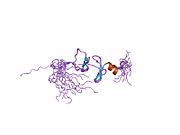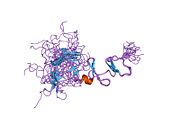FHL1
| View/Edit Human | View/Edit Mouse |
Four and a half LIM domains protein 1 is a protein that in humans is encoded by the FHL1 gene.[5][6][7]
Structure
LIM proteins, named for 'LIN11, ISL1, and MEC3,' are defined by the possession of a highly conserved double zinc finger motif called the LIM domain.[7]
Role in muscle disorders
FHL1 has been shown to be heavily
Limb girdle muscular dystrophy. At least 15 disease-causing mutations in this gene have been discovered.[9]
At present different research groups are using different terminology for these disorders, which include:
- X-linked myopathy with postural muscle atrophy (XMPMA)
- An adult-onset muscle disorder known to affect families in Austria and the UK.[10]
- Reducing body myopathy (RBM)
- A rare disorder causing progressive muscular weakness characterized by aggresome-like inclusions in the myofibrils. The effects of the disorder can be either severe, with onset of weakness at approximately five years, or adult onset, with weakness occurring in the late 20s, early 30s.[11]
- Scapuloperoneal myopathy (SPM)
- Another adult-onset muscle disorder, especially affecting the shoulder girdle and legs.[12]
References
- ^ a b c GRCh38: Ensembl release 89: ENSG00000022267 – Ensembl, May 2017
- ^ a b c GRCm38: Ensembl release 89: ENSMUSG00000023092 – Ensembl, May 2017
- ^ "Human PubMed Reference:". National Center for Biotechnology Information, U.S. National Library of Medicine.
- ^ "Mouse PubMed Reference:". National Center for Biotechnology Information, U.S. National Library of Medicine.
- PMID 8753811.
- PMID 9714789.
- ^ a b "Entrez Gene: FHL1 four and a half LIM domains 1".
- PMID 9714789.
- PMID 31819097.
- PMID 18179888.
- PMID 18274675.
- PMID 18179901.
Further reading
- Morgan MJ, Madgwick AJ, Charleston B, Pell JM, Loughna PT (Jul 1995). "The developmental regulation of a novel muscle LIM-protein". Biochemical and Biophysical Research Communications. 212 (3): 840–6. PMID 7626119.
- Maruyama K, Sugano S (Jan 1994). "Oligo-capping: a simple method to replace the cap structure of eukaryotic mRNAs with oligoribonucleotides". Gene. 138 (1–2): 171–4. PMID 8125298.
- Suzuki Y, Yoshitomo-Nakagawa K, Maruyama K, Suyama A, Sugano S (Oct 1997). "Construction and characterization of a full length-enriched and a 5'-end-enriched cDNA library". Gene. 200 (1–2): 149–56. PMID 9373149.
- Tani S, Taniwaki M, Taniguchi Y, Minoguchi S, Kuroda K, Han H, Aoki T, Miyatake S, Hashimoto N, Honjo T (1999). "Chromosomal mapping of two RBP-J-related genes: Kyo-T and RBP-L". Journal of Human Genetics. 44 (1): 73–5. PMID 9929984.
- Morgan MJ, Madgwick AJ (Feb 1999). "The LIM proteins FHL1 and FHL3 are expressed differently in skeletal muscle". Biochemical and Biophysical Research Communications. 255 (2): 245–50. PMID 10049693.
- Greene WK, Baker E, Rabbitts TH, Kees UR (May 1999). "Genomic structure, tissue expression and chromosomal location of the LIM-only gene, SLIM1". Gene. 232 (2): 203–7. PMID 10352231.
- Brown S, McGrath MJ, Ooms LM, Gurung R, Maimone MM, Mitchell CA (Sep 1999). "Characterization of two isoforms of the skeletal muscle LIM protein 1, SLIM1. Localization of SLIM1 at focal adhesions and the isoform slimmer in the nucleus of myoblasts and cytoplasm of myotubes suggests distinct roles in the cytoskeleton and in nuclear-cytoplasmic communication". The Journal of Biological Chemistry. 274 (38): 27083–91. PMID 10480922.
- Lee SM, Li HY, Ng EK, Or SM, Chan KK, Kotaka M, Chim SS, Tsui SK, Waye MM, Fung KP, Lee CY (Sep 1999). "Characterization of a brain-specific nuclear LIM domain protein (FHL1B) which is an alternatively spliced variant of FHL1". Gene. 237 (1): 253–63. PMID 10524257.
- Ng EK, Lee SM, Li HY, Ngai SM, Tsui SK, Waye MM, Lee CY, Fung KP (2001). "Characterization of tissue-specific LIM domain protein (FHL1C) which is an alternatively spliced isoform of a human LIM-only protein (FHL1)". Journal of Cellular Biochemistry. 82 (1): 1–10. S2CID 25900444.
- Lange S, Auerbach D, McLoughlin P, Perriard E, Schäfer BW, Perriard JC, Ehler E (Dec 2002). "Subcellular targeting of metabolic enzymes to titin in heart muscle may be mediated by DRAL/FHL-2". Journal of Cell Science. 115 (Pt 24): 4925–36. PMID 12432079.
- Gevaert K, Goethals M, Martens L, Van Damme J, Staes A, Thomas GR, Vandekerckhove J (May 2003). "Exploring proteomes and analyzing protein processing by mass spectrometric identification of sorted N-terminal peptides". Nature Biotechnology. 21 (5): 566–9. S2CID 23783563.
- McGrath MJ, Mitchell CA, Coghill ID, Robinson PA, Brown S (Dec 2003). "Skeletal muscle LIM protein 1 (SLIM1/FHL1) induces alpha 5 beta 1-integrin-dependent myocyte elongation". American Journal of Physiology. Cell Physiology. 285 (6): C1513–26. PMID 12917103.
- Qin H, Wang J, Liang Y, Taniguchi Y, Tanigaki K, Han H (2004). "RING1 inhibits transactivation of RBP-J by Notch through interaction with LIM protein KyoT2". Nucleic Acids Research. 32 (4): 1492–501. PMID 14999091.
- Philippar U, Schratt G, Dieterich C, Müller JM, Galgóczy P, Engel FB, Keating MT, Gertler F, Schüle R, Vingron M, Nordheim A (Dec 2004). "The SRF target gene Fhl2 antagonizes RhoA/MAL-dependent activation of SRF". Molecular Cell. 16 (6): 867–80. PMID 15610731.
- Qin H, Du D, Zhu Y, Li J, Feng L, Liang Y, Han H (Feb 2005). "The PcG protein HPC2 inhibits RBP-J-mediated transcription by interacting with LIM protein KyoT2". FEBS Letters. 579 (5): 1220–6. S2CID 8214807.
External links
- GeneReviews/NCBI/NIH/UW entry on Emery–Dreifuss muscular dystrophy
- FHL1+protein,+human at the U.S. National Library of Medicine Medical Subject Headings (MeSH)
This article incorporates text from the United States National Library of Medicine, which is in the public domain.



